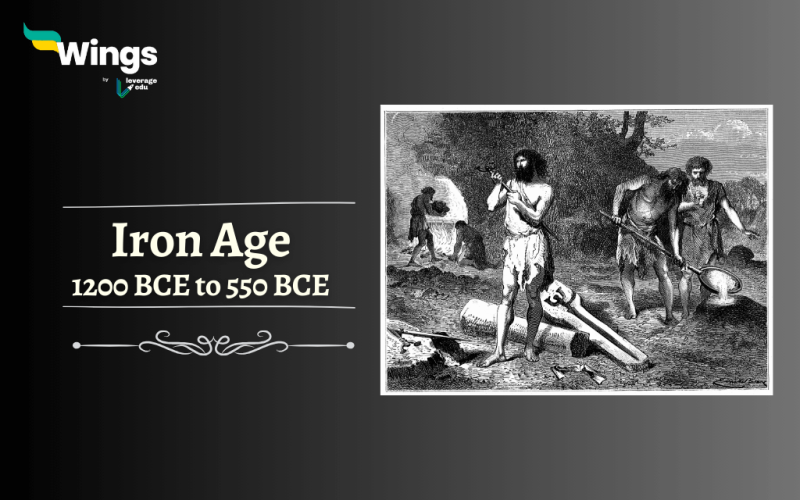The Iron Age is an important time in our human history that was marked by advancements in metallurgy, social and political changes as well as the rise of highly complex civilisations. Moreover, spanning roughly from 1200 BCE to 550 BCE in most parts of the world. The Iron Age introduced a transformative period that was represented by the widespread use of iron tools and weapons, hence replacing the earlier use of bronze.
Table of Contents [show]

What is the Iron Age Period?
It is a period in history wherein the usage of iron began. After the Bronze Age, the use of iron tools and weapons came into force. Additionally, it is generally divided into three sub-periods:
- The Early Iron Age
- The Middle Iron Age
- The Late Iron Age
Furthermore, this period witnessed momentous technological advancements, socio-political evolutions, and the emergence of powerful civilisations across the globe.
Also Read: Stone Age Tools
What were the Main Features of the Age?
In addition, the main features of the Age are as follows:
- Iron Metallurgy: The development and mastery of iron smelting techniques revolutionised tool-making as well as warfare. Hence, leading to the overall acceptance of iron tools and weapons.
- Urbanisation: The Age saw the rise of urban centres and complex societies which was fueled by agricultural surplus and trade networks.
- Increased Warfare: Moreover, the availability of iron weapons further contributed to the rise of militarised states and even conflicts over resources and territory.
- Cultural Exchange: Trade routes grew during this period, thus increasing cultural exchanges and the spread of ideas, technologies, and goods.
- Social Stratification: Additionally, with the growth of urban centres and the blossoming of centralised states, the social hierarchies became more evident. Hence leading to the formation of ruling elites as well as class distinctions.
Also Read: Paleolithic Age: Phases & Features
What were the Iron Age Civilisations?
The Civilisations during the Age were:
- Ancient Near East: Civilizations such as the Hittites, Assyrians, and Babylonians grew during the Age. Moreover, leaving behind rich legacies of architecture, literature, and governance.
- Classical Mediterranean: The Age in the Mediterranean region saw the rise of powerful civilisations like Greece, Rome, and Carthage, thus shaping the course of Western civilisation.
- Central Asia: The Age nomadic tribes, such as the Scythians and Sarmatians, had an important part in shaping the geopolitics of Central Asia and Eastern Europe.
- South Asia: In addition, the Indian subcontinent saw the rise of powerful kingdoms like the Maurya and Gupta empires. They were known for their cultural achievements and modern governance systems.

What was Invented in the Age?
The Iron Age was a time of amazing invention, with substantial progress in different fields:
- Iron Tools and Weapons: The evolution of iron smelting techniques led to the vast production of iron tools and weapons, thus replacing earlier bronze tools.
- Iron Plowshares: Moreover, the introduction of iron ploughshares revolutionised agriculture. Hence improving agricultural productivity and boosting the growth of settled societies.
- Writing Systems: Many Iron Age civilisations invented or refined old writing systems. They were the Phoenician alphabet and the Brahmi script in South Asia. This helped them to keep a record of history, literature, as well as administrative records.
- Urban Planning: Urban centres during this span saw progress in city planning, architecture, and infrastructure. It included the construction of defensive walls, temples, and palaces.

What is the Iron Age of Indian History?
In the Indian subcontinent, the Iron Age is commonly associated with the Vedic period. Moreover, there was the rise of powerful kingdoms such as the Maurya and Gupta empires. Furthermore, this period was a part of important cultural, technological, as well as philosophical developments. Thus, including the composition of the Vedas, the emergence of Hinduism and Buddhism, and the establishment of sophisticated urban centres like Pataliputra.
FAQs
The 3 Iron Ages are: Early, Middle and Late Age.
The Age earned its name due to the widespread adoption of iron tools and weapons. Hence marking a significant technological shift from the previous dominance of bronze in craftsmanship and warfare. This era heralded a new chapter in human history characterised by the transformative impact of iron metallurgy on societies worldwide.
The Hittites are among the earliest known civilisations to extensively use iron. Moreover, dating back to around 2000 BCE, marking the onset.
The Iron Age typically ended around 550 BCE in most regions. Thus marking the transition to the subsequent historical period characterised by further technological advancements and socio-political changes.
The Hittites, an ancient civilisation of Anatolia, were among the first to widely use iron weaponry and tools during the Late Bronze Age and Early Iron Age.
Relevant Blogs
| Mesolithic Age | Neolithic Age |
| Yadava Dynasty | Major Climatic Change After Ice Age |
| Satavahana Dynasty | The 16 Mahajanapadas |
| The History of Indian Art | Tughlaq Dynasty |
| Gurjara-Pratihara Dynasty | Haryanka Dynasty |
This was all about the Iron Age. If you are interested in learning more about such historical topics, then you can find more informative blogs on Indian History by staying tuned to our General Knowledge section.
 One app for all your study abroad needs
One app for all your study abroad needs















 45,000+ students trusted us with their dreams. Take the first step today!
45,000+ students trusted us with their dreams. Take the first step today!
